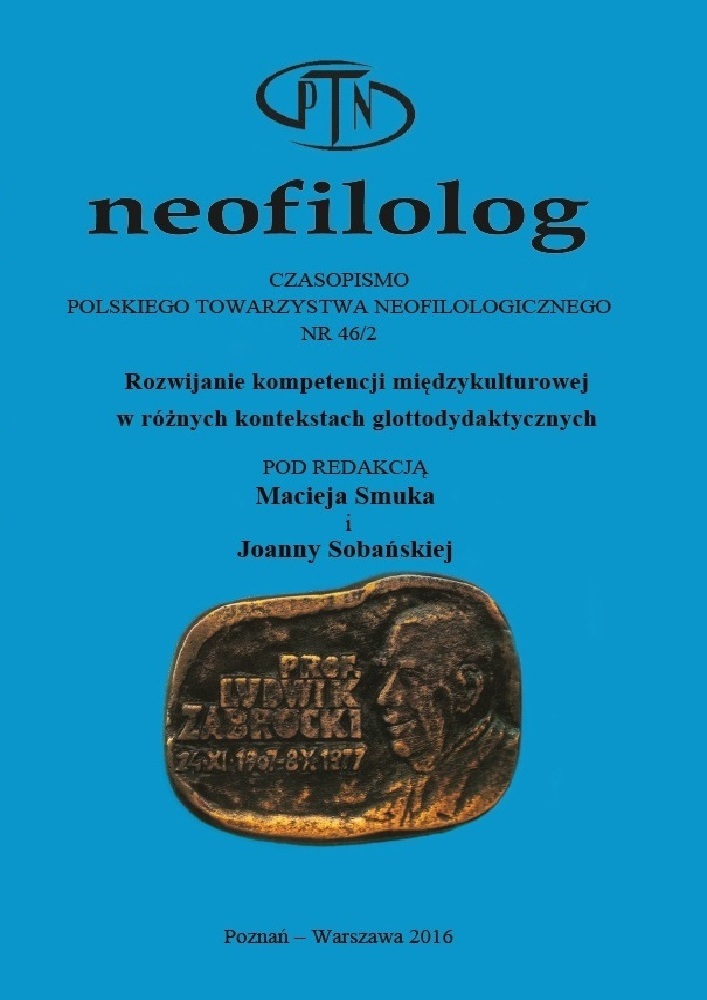Abstrakt
The paper discusses specific features of the Swedish sociocultural reality and the way the sociocultural diversity of the country is presented in language textbooks for Swedish language learners. The analysis is longitudinal in nature i.e. it concerns two editions of textbooks published in Sweden between 1996 and 2014. The presentation of Swedish sociocultural diversity is both explicit and implicit in nature, with changes in ethnic diversity, household diversity, and family diversity being the most dynamic ones. However, a number of differences between both textbooks are noticeable: in the older version information is presented mainly in an explicit form while its newer counterpart demonstrates the diversity of Swedish society both explicitly and implicitly.
Bibliografia
Byram, M. 1989. Cultural Studies in Foreign Language Education. Clevedon – Philadelphia: Multilingual Matters.
Byram, M. i M. Fleming. 1998. Language Learning in Intercultural Perspective. Cambridge: Cambridge University Press.
Byram, M., Nichols, A. i D. Stevens. 2001: „Introduction”. (w) Languages for Intercultural Communication and Education, 1: Developing Intercultural Competence in Practice. (red. M. Byram, A. Nichols i D. Stevens). Clevedon: Multilingual Matters Limited, str. 1-8.
Domeji, R. 2010. „Elektronisk kommunikation – möjligheter och svårigheter”. Wykład wygłoszony podczas konferencji ASLA. Språk för framtiden. Falun, 12-13 listopada 2010.
Encyklopedia PWN. [online: http://encyklopedia.pwn.pl/haslo/kultura;3928887.html; DW 8.01.2016].
Główny Urząd Statystyczny. 2015. [online: http://stat.gov.pl/obszary-tematyczne/ludnosc/ ludnosc/ludnosc-stan-i-struktura-ludnosci-oraz-ruch-naturalny-w-przekroju-ter ytorialnym-stan-w-dniu-31-xii-2014-r-,6,17.html; DW 8.01.2016].
Migrationsverket. 2016. [online: http://migrationsverket.se; DW 8.01.2016].
Parkvall, M. 2009. Sveriges språk. Vem talar vad och var? RAPPLING 1. Rapportert från institutionen för lingvistik. Stockholms universitet.
Słownik języka polskiego. [online: http://sjp.pwn.pl/sjp/kultura;2565197.html; DW 8.01.2016].
Statistik för alla 2015/2016. 2015. Örebro: Statistiska Centralbyrån. [online: http://scb.se; DW 8.01.2016].
Tomlinson, B. 2000. „Materials for cultural awareness: combining language, literature and culture in the mind”. The Language Teacher, 24(2): 19-21.
Tronsoco, C. R. 2010: „The effects of Language Materials on the Development of Intercultural Competence”. (w) Research for Materials Development in Language Learning: Evidence for Best Practice. (red. B. Tomlinson i H. Masuhara). London: GBR: Continuum International Publishing, str. 83-102.
Wielki słownik języka polskiego. [online: http://wsjp.pl/index.php?id_hasla=3479&ind= 0&w_szukaj=kultura; DW 8.01.2016].
Licencja
Prawa autorskie (c) 2018 Iwona Kowal

Utwór dostępny jest na licencji Creative Commons Uznanie autorstwa – Bez utworów zależnych 4.0 Międzynarodowe.
Przedstawiany utwór (artykuł) upubliczniany jest na podstawie umowy z autorem i na licencji Creative Commons Attribution-NoDerivatives 4.0 International (CC BY-ND 4.0).
Użytkownicy mają obowiązek podania wraz z rozpowszechnionym utworem, informacji o autorstwie, tytule, źródle (odnośniki do oryginalnego utworu, DOI) oraz samej licencji;
- bez tworzenia utworów zależnych,
- utwór musi być zachowany w oryginalnej postaci.
Uniwersytet im. Adama Mickiewicza w Poznaniu zachowuje prawo do czasopisma jako całości (układ, forma graficzna, tytuł, projekt okładki, logo itp.).
